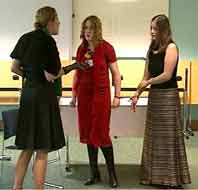Playing Spaces in Renaissance Drama
Extracts from Professor Alison Findlay’s Inaugural Lecture
 Virginia Woolf famously claimed that England would have offered no playing space to a talented sister of Shakespeare. Drama in the age of Shakespeare conjures up images of public amphitheatres: the Globe, the Swan, the Rose, the Hope or the Red Bull or indoor theatre venues, such as the Blackfriars and the Inns of Court…
Virginia Woolf famously claimed that England would have offered no playing space to a talented sister of Shakespeare. Drama in the age of Shakespeare conjures up images of public amphitheatres: the Globe, the Swan, the Rose, the Hope or the Red Bull or indoor theatre venues, such as the Blackfriars and the Inns of Court…
However, theatre was not monopolised by all-male companies like the King’s Men. Neither was it an exclusively metropolitan phenomenon. These images do not tell the full story. In the same way that the canon of literature has exploded to juxtapose Wordsworth’s famous poetic daffodils with his sister’s account of them in her journal, so the canon of Renaissance drama must be opened to make space for other venues and writers, readers and performers. Moving beyond the purpose-built theatres in London allows us to take account of venues in the regions to which professional companies toured, and in which home-grown drama was produced. Crucially, this move creates a space in which we can appreciate the work of Shakespeare’s sisters alongside those of the Bard.
 Mariam Queen of Jewry, written in 1606 by Lady Elizabeth Cary, makes brilliant use of a prison setting to comment on the confinement of women’s cultural identity and performance opportunities. This slide shows a student presentation of the prison scene where the heroine Mariam, who strives to escape from her position as Herod’s wife, is confronted by his divorced wife Doris who longs to return to her place.
Mariam Queen of Jewry, written in 1606 by Lady Elizabeth Cary, makes brilliant use of a prison setting to comment on the confinement of women’s cultural identity and performance opportunities. This slide shows a student presentation of the prison scene where the heroine Mariam, who strives to escape from her position as Herod’s wife, is confronted by his divorced wife Doris who longs to return to her place.
As my students explored by working practically with the text, Cary’s scene makes it obvious that both women are equally confined: one physically and one metaphorically by the narrow roles ascribed to women in early modern England. Mariam’s identity is split (she is played by two actors handcuffed together to show that because she speaks her mind publicly, she cannot escape her reputation as a whore). Doris is equally imprisoned by her roles as wife and mother (clutching photographs of her children). When performed in a household, the prison setting also constitutes a critical commentary on its own venue: for seventeenth century women, dramatic activity (like Cary’s) is unjustly imprisoned in the house. Salome, Cary’s most outspoken female character, declares that she will show her sex the way to freedom’s door. Cary’s script cannot open the door, but it plays out the bitterness of imprisonment.
The following clips are from a student production of Mariam Queen of Jewry for Professor Findlay’s half-unit course, English 357: Feminist Perspectives on Renaissance Drama, and from an interview with the students involved.
View performance and interview on YouTube.
